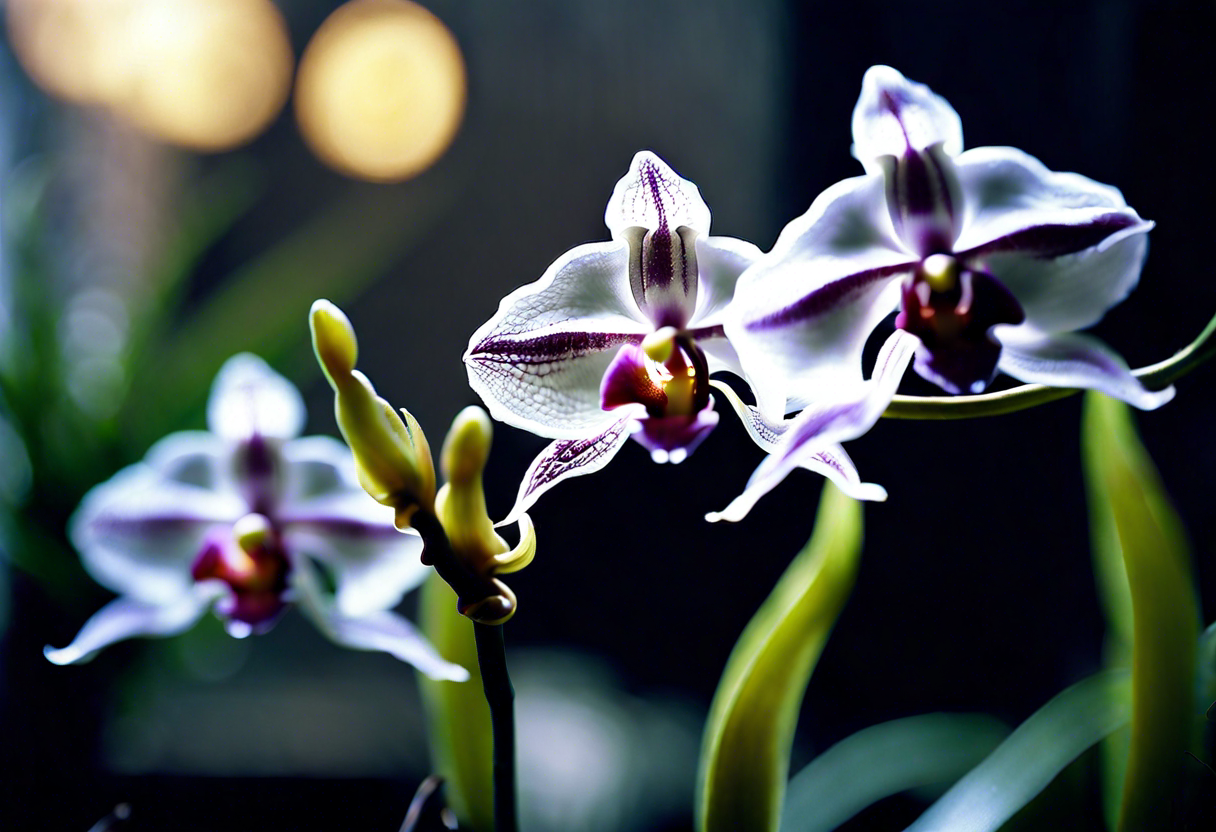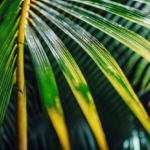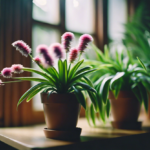The Enigma of Ghost Orchid Flowers
The Ghost Orchid, scientifically known as Dendrophylax lindenii, is a mesmerizing flower that captivates botanists, nature enthusiasts, and adventure seekers alike. Its elusive nature and mysterious beauty have earned it the title of one of the most enigmatic flowers in the world. Let us delve into the intriguing world of Ghost Orchid flowers and uncover the secrets that surround them.
The Ghost Orchid is native to the subtropical swamps of Cuba, the Bahamas, and Florida. Its natural habitat consists of dense, humid forests, where these flowers find their sanctuary. Despite their limited geographical range, these orchids have fascinated botanists for centuries.
One of the most distinguishing features of the Ghost Orchid is its ethereal appearance. Unlike most orchids, it lacks leaves and depends solely on its roots for sustenance. Its slender, trailing roots intertwine with the host tree, providing stability and nourishment. The flower itself is a delicate translucent structure that seems to float in mid-air, adding to its elusive allure.
The blooms of the Ghost Orchid have a unique shape and structure. They consist of elongated petals that form a slender tube, resembling the flowing robes of a ghostly apparition. The flowers are usually white and occasionally tinged with pink or purple, further adding to their otherworldly charm. Each flower typically measures around 10 to 12 centimeters in diameter.
Ghost Orchid flowers are shrouded in mystery when it comes to their pollination strategy. Unlike most orchids that rely on insects for pollination, these enigmatic flowers have peculiar adaptations. They produce a fragrance reminiscent of rotting fruit, attracting nocturnal moths as their primary pollinators. These moths seek out the scent, enter the flower in search of nectar, and inadvertently assist in the orchid’s pollination process.
Conserving Ghost Orchid flowers is of paramount importance due to their scarcity and vulnerability. Habitat destruction, illegal collection, and climate change pose significant threats to these delicate beauties. Conservation efforts focus on protecting the habitats where Ghost Orchids thrive and raising awareness about their importance in maintaining ecological balance.
Ghost Orchid flowers remain an enigma that continues to enthral botanists and nature enthusiasts alike. Their ethereal appearance, unique adaptations, and delicate beauty make them a wonder to behold. By understanding and conserving these elusive flowers, we can ensure that future generations can marvel at their mystique and appreciate the intricate wonders of the natural world.
Habitat and Distribution of Ghost Orchid Flowers
Ghost orchid flowers, scientifically known as Dendrophylax lindenii, are intriguing and rare plant species that captivate botanists and nature enthusiasts alike. With its ethereal beauty and mysterious nature, the ghost orchid has earned a reputation as one of the most elusive and sought-after orchids in the world.
The natural habitat of ghost orchid flowers is primarily found within the humid and swampy regions of Florida’s Everglades and Cuba. These delicate orchids have adapted to thrive in the unique environment of these wetland ecosystems, where they often grow in the shady understory of dense, old-growth forests.
Given their specialized requirements, ghost orchids are highly selective when it comes to choosing their preferred microhabitats. They typically grow on the trunks or large branches of trees such as cypress, pop ash, and pond apple, forming mutualistic relationships with their host plants. The ghost orchid’s roots can merge with the host tree’s aerial roots, creating a symbiotic bond that allows them to obtain essential nutrients and moisture.
Unfortunately, due to their specific habitat requirements and limited geographical range, ghost orchid flowers are considered critically endangered. Their distribution is primarily restricted to a few known sites, making them susceptible to habitat loss, illegal collection, and climate change.
Conservation efforts have been initiated to protect and preserve these delicate orchids. Organizations such as the Florida Panther National Wildlife Refuge and the Orchid Recovery Program work diligently to safeguard their fragile habitats and raise awareness about the importance of conservation.
Ghost orchid flowers are fascinating and elusive orchids with a habitat confined to the swampy regions of Florida’s Everglades and Cuba. Their unique interactions with their host trees, coupled with their restricted distribution, make them truly remarkable and worthy of conservation efforts. By understanding and appreciating the delicate balance between these rare orchids and their environment, we can hope to ensure the survival of these ethereal flowers for generations to come.
The Anatomy and Morphology of Ghost Orchid Flowers
Ghost orchid flowers, scientifically known as Dendrophylax lindenii, are incredibly unique and fascinating in their anatomy and morphology. These ethereal flowers have captivated botanists and orchid enthusiasts alike with their enigmatic beauty. Let us delve deeper into the intricate details of the ghost orchid flowers.
The ghost orchid is a leafless epiphyte, meaning it grows on the surface of other plants and derives nutrients and moisture from the air and rain. It is primarily found in the swamps and wetlands of Florida and Cuba, making it a rare and elusive sight for many. The flowers bloom from the base of the stem, creating an alluring display of delicate white petals.
One of the most striking features of ghost orchid flowers is their lack of leaves. This absence of foliage allows the flowers to blend seamlessly into their surroundings, giving them an almost ghost-like appearance, hence the name "ghost orchid." Despite their leafless nature, these orchids are still able to perform photosynthesis through their roots and specialized tissues.
The ghost orchid flowers typically have a single stem that can reach impressive lengths of up to three feet. At the end of the stem, a cluster of around five to ten flowers emerges, each measuring approximately three inches in diameter. These flowers possess an otherworldly beauty, with slender, elongated sepals and a stunning white coloration that contrasts against their dark, forested habitats.
Another distinctive feature of the ghost orchid flowers is their unique pollination mechanism. These orchids do not rely on bees or other common pollinators but instead, have a symbiotic relationship with a specific moth species, the giant sphinx moth (Cocytius antaeus). The flowers emit a powerful and intoxicating fragrance at night, attracting the male moths with their irresistible scent. As the moths visit these flowers in search of nectar, they inadvertently pick up or deposit pollen, aiding in the orchid’s reproduction.
In terms of morphology, the ghost orchid flowers have a fascinating structure. The central column of the flower, known as the column or gynostemium, houses both the male and female reproductive structures. The stigma, which receives the pollen, is located at the top of the column, while the anther, which produces the pollen, is positioned below. This arrangement promotes cross-pollination and ensures the orchid’s genetic diversity.
Ghost orchid flowers are a marvel of nature, both in their anatomy and morphology. Their leafless nature, stunning white petals, and unique pollination mechanism make them a true enigma. As we continue to delve deeper into the world of orchids, these ghostly beauties remain a captivating mystery waiting to be unraveled.
The Interactions Between Ghost Orchid Flowers and Pollinators
Ghost Orchid flowers (Dendrophylax lindenii) have captivated botanists and nature enthusiasts for many years due to their unique and intriguing interactions with pollinators. These rare and elusive orchids, found in the wetlands and swamps of Florida and Cuba, have developed fascinating adaptations to attract their specialized pollinators and ensure their continued survival.
One of the most remarkable aspects of Ghost Orchid flowers is their dependence on specific moths for pollination. These moths belong to the genus Pseudosphinx and are the primary pollinators of the Ghost Orchid. The flowers emit a sweet, nocturnal fragrance that mimics the pheromones released by female moths, attracting the males in search of mates. As the male moths fly towards the scent, they inadvertently pick up and transfer the orchid’s pollen, thus facilitating cross-pollination.
The Ghost Orchid’s flowers are uniquely adapted to accommodate the specific pollinators. The flowers lack nectar, unlike many other orchid species, as they rely solely on attracting the male moths through their scent. The blossoms are usually white and bloom in clusters at the end of long, slender stalks. This positioning and coloration make them highly visible to the moths, ensuring a higher chance of successful pollination.
The Ghost Orchid’s reliance on a specific moth species for pollination poses both benefits and challenges. On one hand, this specialization ensures a higher success rate in pollination as the moth’s unique behavior aligns perfectly with the orchid’s adaptations. On the other hand, any disruption in the moth population or habitat can have detrimental effects on the Ghost Orchid’s reproductive success.
Conservation efforts are crucial to the survival of the Ghost Orchid and its pollinators. Protecting and preserving the wetland ecosystems where these orchids thrive is essential, as it ensures the availability of suitable habitats for the moths. Additionally, raising awareness about the Ghost Orchid’s importance and promoting responsible ecotourism can contribute to its conservation by generating funds for habitat restoration and supporting research initiatives.
In recent years, advancements in technology have helped shed light on the ethereal dance between Ghost Orchid flowers and their pollinators. Researchers have used infrared cameras and motion-sensor-triggered photography to capture these interactions, providing valuable insights into their behavior and reproductive strategies. These studies have further emphasized the need to protect both the Ghost Orchid and its pollinators to maintain the delicate balance within their ecosystems.
The interactions between Ghost Orchid flowers and their pollinators, specifically the moth species Pseudosphinx, are a fascinating example of nature’s intricate relationships. The orchids’ adaptations, such as their sweet fragrance and distinctive appearance, ensure their successful pollination. Conservation efforts are crucial in safeguarding the Ghost Orchid and its specialized pollinators, as they rely on healthy wetland ecosystems for their survival. Studying and protecting these interactions is vital for preserving the beauty and diversity of our natural world.
Glimmers of Hope: Conservation Efforts for Ghost Orchid Flowers
The spectral beauty of the Ghost Orchid flowers is not only captivating but also incredibly elusive. These ethereal blooms, scientifically known as Dendrophylax lindenii, have gained fame as one of the rarest and most enigmatic orchid species in the world. As these delicate flowers dance upon the branches of trees, a sense of urgency surrounds their conservation. Dedicated efforts are being made to protect and preserve these precious orchids, ensuring their survival for generations to come.
Habitat Preservation: Ghost Orchid flowers thrive in unique ecosystems, primarily in the swamps and wetlands of Florida, Cuba, and the Bahamas. The delicate balance of these habitats is crucial for the orchids’ survival. To safeguard their existence, conservation organizations focus on preserving the natural habitats where these flowers grow. Through land acquisition, regulation enforcement, and public education, these organizations actively work towards conserving the critical ecosystems that sustain Ghost Orchid flowers.
Research and Monitoring: Understanding Ghost Orchid flowers is a prerequisite for their conservation. To unravel the secrets surrounding their growth, reproduction, and interaction with their environment, scientists and botanists diligently conduct research and monitoring programs. These initiatives provide valuable insights into the Ghost Orchid’s life cycle, population trends, and the factors affecting their survival. Armed with this knowledge, conservationists can develop targeted strategies to protect and support these mesmerizing flowers.
Captive Propagation: Capturing the ephemeral beauty of Ghost Orchids presents a unique challenge, as their cultivation outside their native habitats is highly intricate. However, conservationists are making strides in propagating Ghost Orchid flowers in specialized facilities with controlled environments. By carefully studying their complex requirements, including humidity, temperature, and lighting conditions, conservationists aim to mimic their natural habitats. Captive propagation allows for the establishment of assurance colonies, safeguarding the species from extinction while also reducing the demand for wild specimens.
Public Engagement: Raising awareness among the general public is crucial in garnering support for Ghost Orchid conservation efforts. Public engagement programs, such as guided tours, lectures, and workshops, play a vital role in educating people about the importance of these elusive flowers. By fostering a sense of connection and understanding, these initiatives inspire individuals to become advocates for Ghost Orchid conservation. Additionally, promoting responsible behavior in natural habitats helps prevent unintentional damage to these delicate ecosystems.
Partnerships and Collaborations: Conservation efforts for Ghost Orchid flowers thrive on partnerships and collaborations between various stakeholders. Government agencies, private organizations, researchers, and local communities combine their expertise and resources to create comprehensive conservation strategies. By pooling their knowledge and efforts, these collaborations maximize the impact of conservation initiatives and ensure a holistic approach towards safeguarding the future of Ghost Orchid flowers.
The conservation efforts for Ghost Orchid flowers represent a beacon of hope amidst the challenges they face. By preserving their habitats, conducting research, practicing captive propagation, engaging the public, and fostering collaborations, society can actively contribute to the survival and prosperity of these mesmerizing flowers. Through unified actions, we can ensure that future generations can witness the enchanting dance of Ghost Orchid flowers in the wilderness for years to come.
Conclusion
The enigmatic and mesmerizing Ghost Orchid flowers continue to captivate researchers, botanists, and nature enthusiasts alike. Despite their elusive nature and limited distribution, these unique flowers have fascinated many with their unique characteristics and captivating beauty.
The Ghost Orchid flowers are primarily found in the swampy habitats of Florida, Cuba, and the Bahamas. Their chosen habitats such as wetlands and cypress swamps highlight their adaptability to specific ecological niches. However, due to habitat loss and human interference, their distribution has become increasingly restricted, making these flowers even more elusive and sought-after.
Understanding the anatomy and morphology of Ghost Orchid flowers has been crucial in unraveling their mysteries. With their long, slender stems and translucent, ghostly appearance, they truly live up to their name. The flowers lack leaves, relying solely on their intricate root systems for sustenance, leading to their dependence on a specific mycorrhizal fungus for survival. This intricate relationship highlights the delicate balance necessary for their reproduction and survival.
Another intriguing aspect of Ghost Orchid flowers is their interactions with pollinators. Due to their lack of scent and nectar, these flowers have evolved peculiar strategies to attract pollinators, primarily moths. The flowers emit faint ultraviolet patterns, which serve as a guiding light for their pollinators, attracting them to the intricate structures that house the flowers’ reproductive organs. This remarkable adaptation showcases the intricate mechanisms flowers employ to ensure successful pollination.
Given their restricted distribution and vulnerable status, conservation efforts are crucial in preserving Ghost Orchid flowers for future generations. These efforts include protecting their habitats, minimizing human interference, and raising awareness about their significance. Conservation organizations, botanic gardens, and government initiatives have played a pivotal role in preserving and rehabilitating these delicate flowers, ensuring their long-term survival.
The enigma of Ghost Orchid flowers lies not only in their elusive nature and breathtaking beauty but also in their intricate interactions with their environment. Their limited distribution and unique adaptations highlight the importance of further research and conservation efforts. By understanding and appreciating these fascinating flowers, we can contribute to their preservation and ensure that future generations can continue to marvel at their ghostly elegance.


